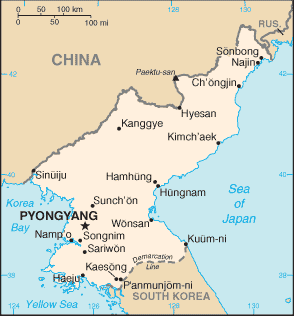Getting North Korea into China’s Belt and Road Initiative


A statue of a Chinese aviator looking towards North Korea on the banks of the Yalu River
Seventeen years ago, I raised my hand at the Shanghai APEC meeting taking place at the Grand Hyatt in Pudong, to ask Russian President Vladimir Putin a question. “North Korea is an Asia-Pacific nation. Do you think it prudent to allow North Korea observer status to APEC?”
There was a collective gasp from the audience – I had mentioned the elephant in the room no-one dare discuss. Kim Jong-Il however had been to visit Moscow just a week earlier, and I had recently returned from a business evaluation trip to Pyongyang. Putin didn’t reply directly, but did stress that Russia and North Korea had shared a common border and trade for decades, and although that he acknowledged things were ‘tough’, he gave away enough to suggest he’d be for such a move.
At that time, North Korea did not possess nuclear weapons, and China was reaching out to Pyongyang to try and educate it on the merits of market reforms. However, George W. Bush was also at that conference, and had just referred to North Korea as “an axis of evil”. There were subsequently no overtures to allow North Korea access to even observe APEC’s mechanisms for trade, and in the light of perceived US aggression, a program was started in Pyongyang to allow the regime to protect themselves. In hindsight, it probably would have been a very good thing if North Korea had been encouraged, just as China was trying to do, rather than demonized, as was the American stance. One has to say the US stance hasn’t worked very well, at least in the diplomatic sense. Pyongyang now has nuclear weapons. It might well have been more prudent to follow China’s lead and my suggestions to encourage rather than threaten them.
Today, in a weaponized North Korea, we stand at the cusp of what could be a remarkable coup by US President Donald Trump – negotiating a dis-armament deal with Pyongyang. It won’t be easy, and it won’t happen overnight. But part of such a deal will include trade. That will interest both China, Russia and South Korea, and will bring both North Korea and the Korean Peninsula as a whole very firmly into China’s Belt & Road Initiative. But what can North Korea offer?
For a start, the country, long close to China, will require massive infrastructure development. Hardly any major infrastructure has been put in place since the 1950’s. China and its SOE’s, and long border with North Korea, will be more than willing to assist and would in many respects be an ideal partner. Russia too, with its rail links reaching down from the North will also be able to help develop North Korean infrastructure, while the South would be keen to get involved and supply IT and services support.
But apart from a need to upgrade its infrastructure, what happens next? In fact, North Korea sits on the richest part of the Korean Peninsula. It possesses considerable mineral reserves, including precious metals and rare earths, and has reasonable textiles, agricultural and fishery industries and products. Estimates of mineral wealth vary from between US$6 trillion to US$10 trillion in reserves. China, as we have explored recently in our series on building up their Gold reserves, will be very interested to get access to these. The reserves can also be used as collateral to pay for mining and extraction as well as to develop North Korean sovereign wealth. That would be a boon to South Korea, itself leery of the sheer cost of reunification. It may suit both Beijing and Seoul for North Korea to remain independent, yet open to investment on sustainable terms. In may also help Kim Jong-Un evolve himself from North Korean despot to regional saviour. Its not beyond the realms of fantasy – Kim was educated in Switzerland and knows perfectly well how life is like in the West.
North Korean fisheries are at present under-utilized, while their products are sought after in Japan and South Korea. North Korean Ginseng is regarded as the worlds best, and is subsequently highly valued in Far East Asia. Dezan Shira & Associates established Representative Offices for several North Korean Ginseng traders in Beijing in the late 1990’s.
Opening up the North Korean agricultural and fisheries industries will attract huge investment from these nations as well as China. The north-eastern coast of North Korea also has existing developments, and in particular the Raijin-Sonborg Port and Special Economic Zone, whose foreign investment laws I was invited by the North Korean Ministry of Commerce to help research and draft back in 2002. This eventually resulted in modifications being made to the “Law of the Democratic People’s Republic of Korea on the Rason Economic and Trade Zone”, and was based on my knowledge and work undertaken by Dezan Shira & Associates in China, where the practice had made some recommendations to various provincial Chinese and international governments over tax structuring in SEZ’s from the perspective of widening the tax base for foreign investors.
The Raijin-Sonberg Port is useful for both China and Russia, as it offers warm water access, and has in the past been utilized extensively by South Korean manufacturers. Sanctions have placed it largely in mothballs, however upgrading it should relations start to improve will offer China’s north-eastern, yet landlocked provinces of Jilin and Heilongjiang access to a nearby Port close to South Korea, Japan, and facing the West coast of the United States. It is a strategically important location, and just one of several ports that could be redeveloped along the DPRK’s western and eastern seaboards.

Then there is the cheap labor. In fact, while not even realizing it, many American and European politicians are walking around today wearing suits and garments finished in North Korea, and will have indirectly contributed to their economy. This is because under internationally agreed “rules of origin”, certain procedures, such as the sewing of buttons and hems on garments and suchlike, can be carried out in a third country. I have visited factories in Pyongyang where major international brands, including well known upmarket American, European and Japanese labels are being completed for export under the watch of Chinese entrepreneurs able to later sew in “Made in China” tags badge at their factory in Liaoning, Jilin or other nearby province, then export the finished article onto the world markets. It remains an irony that Washington political hawks may be wearing shirts and suits partially crafted by North Korean hands. North Korean labor is about 20-30% of that payable in China’s neighboring Liaoning and Jilin Provinces.
In short, the United States, should President Trump be able to persuade Kim Jong-Un to give up his nuclear missiles, could usher in a whole new era of redevelopment for North-East Asia, while at the same time, save the American tax-payer billions of dollars a year in keeping the current status quo alive. For a man priding himself as a deal-maker, such an achievement would define his Presidency and potentially elevate him among the greats. It remains to be seen which is the stronger of the two in Washington – the US Military, or Donald Trumps ego. If the latter prevails, North Korea will become part of China’s Belt & Road Initiative. Such a move would be a regional game-changer.
About Us
Silk Road Briefing is produced by Dezan Shira & Associates. The firm provides business intelligence, investment advisory, due diligence, tax advisory, corporate establishment and structuring, accounting, payroll and related professional services throughout China, India, ASEAN, Russia and the Eurasian region, servicing both Governments and Multinational clients. To contact us please email silkroad@dezshira.com or visit us at www.dezshira.com
 Related Reading:
Related Reading:
![]() The Definitive Guide to North Korea
The Definitive Guide to North Korea
North Korea Special Issue
This special North Korean issue of China Briefing from 2002 provides a detailed business and investment overview about the country.
DPRK Business Monthly
This regular publication looks at current international, domestic, and peninsular affairs concerning North Korea while also offering commentary and tourism information on the country.
DPRK Rajin-Sonbong Economic & Trade Zone
This UNDP report is a special guide on the climate for foreign investment and foreign transit trade in the Democratic People’s Republic of Korea’s Tumen River Area, specifically focusing on the Rajin-Sonbong Economic and Trade Zone.








